QUM in Practice: Analysis of a Case Study and Recommendations
VerifiedAdded on 2022/08/17
|8
|2245
|11
Report
AI Summary
This report analyzes the Quality Use of Medicines (QUM) principles within the context of a case study involving a 79-year-old patient, Mrs. McIntyre, who experiences multiple health conditions and takes numerous medications. The assignment highlights critical issues such as polypharmacy, medication adherence problems, and the patient's lack of health literacy, leading to potential medication errors and financial strain. It identifies violations of the Australian National Medicines Policy, including a lack of collaborative care and patient education. The report recommends strategies for improvement, such as reducing the number of medications, enhancing health literacy, implementing medication reminders, and increasing pharmacist involvement. It emphasizes the importance of a multidisciplinary approach to patient care, including regular evaluations and training to improve the quality use of medicines and patient outcomes. The report stresses the need for community awareness programs and the significance of non-pharmacological treatments and person-centered care to ensure safe and effective medication management.
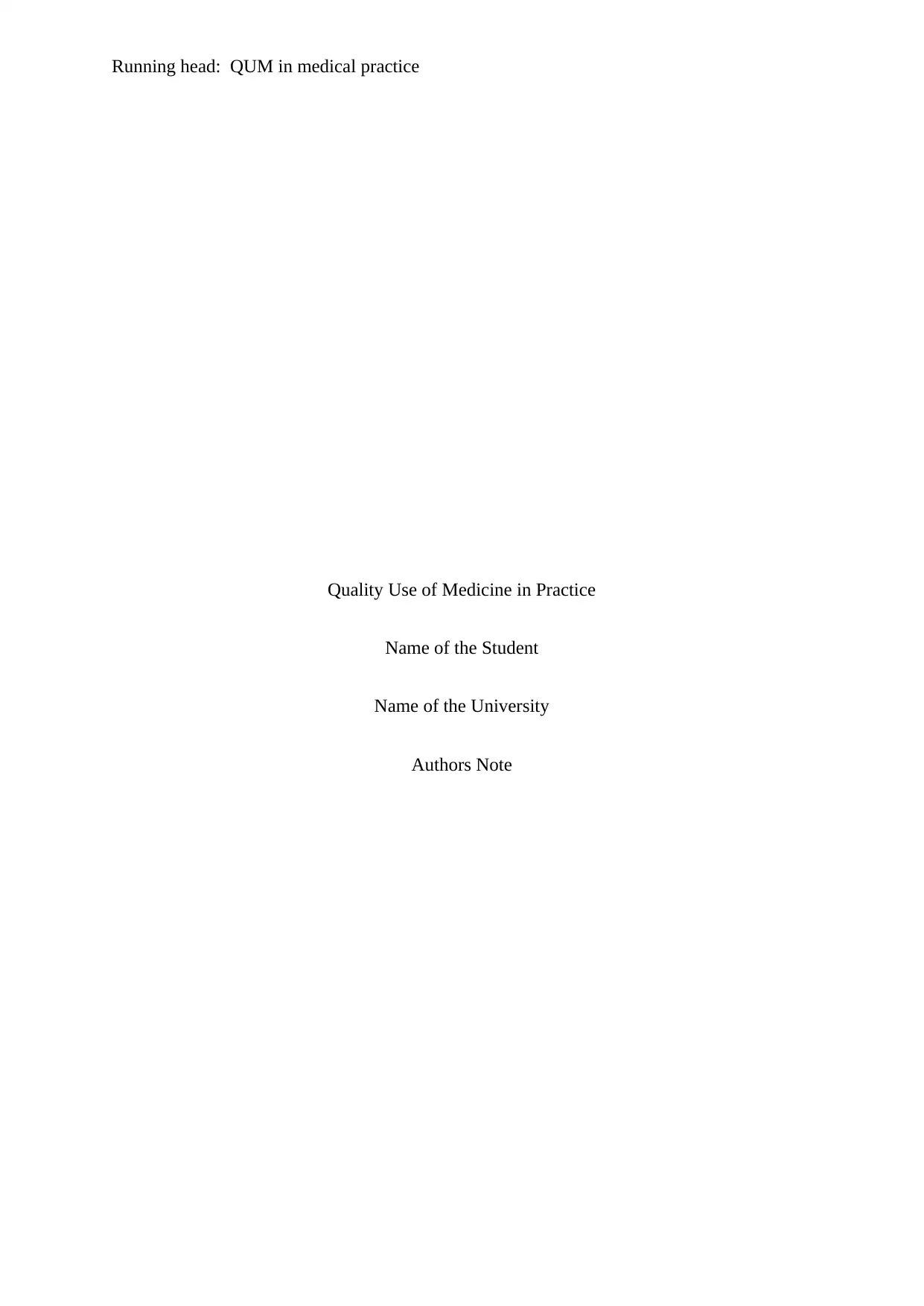
Running head: QUM in medical practice
Quality Use of Medicine in Practice
Name of the Student
Name of the University
Authors Note
Quality Use of Medicine in Practice
Name of the Student
Name of the University
Authors Note
Paraphrase This Document
Need a fresh take? Get an instant paraphrase of this document with our AI Paraphraser

1Quality Use of Medicine in Practice
Introduction
The assignment focuses on the relevance of the QUM principles regarding
consumption of the medications. QUM or Quality Use of Medicines is one of the most
important part of the National Medical Policy of Australia. The aims of QUM are to improve
the health condition of Australian population by administrating quality medicines and
maintaining the medicines as per doctor’s prescription (Thomas, Sundararaj, Shirwaikar &
Shirwaikar, 2017). QUM focuses on the selection of better and appropriate medications as
per the requirements of patients. The QUM is necessary to promote safe and effective
medications. This essay will critically analyse major issues with the reference of the case
study of a 79 years old patient. Effectiveness of the medicines and recommendations to
prevent the issues related to observed discrepancies and erroneous activities related to
medical adherence.
Discussion
The case study describes that a 79 year old patient named Mrs Mclntyre, who needs to
take different types of medicines for resolving several health conditions. The patient faced
myocardial infractions for three times. She faced the condition of myocardial infraction eight,
five and two years ago respectively. Acute episodes of GORD (Gastro-Oesophageal Reflux
Diseases) were faced by the patient along with pneumonia so that she was needed to admit in
the hospital. The patient has the tendency of fall and she can execute some of her daily life
activities such as cooking. Her daughter helps her in grocery and other activities. The patient
was prescribed multiple numbers of medicines. She was prescribed Digoxin 62.5 mcg,
Warfarin 3mg , Omeprazole 20mg , Lisinopril 10mg and Atorvastatin 20mg as daily dosage
of medicines. With the above mentioned medicines Bisoprolol 5mg, Potassium Chloride
20mEq and paracetamol 650mg twice daily. Additionally there are other different types of
Introduction
The assignment focuses on the relevance of the QUM principles regarding
consumption of the medications. QUM or Quality Use of Medicines is one of the most
important part of the National Medical Policy of Australia. The aims of QUM are to improve
the health condition of Australian population by administrating quality medicines and
maintaining the medicines as per doctor’s prescription (Thomas, Sundararaj, Shirwaikar &
Shirwaikar, 2017). QUM focuses on the selection of better and appropriate medications as
per the requirements of patients. The QUM is necessary to promote safe and effective
medications. This essay will critically analyse major issues with the reference of the case
study of a 79 years old patient. Effectiveness of the medicines and recommendations to
prevent the issues related to observed discrepancies and erroneous activities related to
medical adherence.
Discussion
The case study describes that a 79 year old patient named Mrs Mclntyre, who needs to
take different types of medicines for resolving several health conditions. The patient faced
myocardial infractions for three times. She faced the condition of myocardial infraction eight,
five and two years ago respectively. Acute episodes of GORD (Gastro-Oesophageal Reflux
Diseases) were faced by the patient along with pneumonia so that she was needed to admit in
the hospital. The patient has the tendency of fall and she can execute some of her daily life
activities such as cooking. Her daughter helps her in grocery and other activities. The patient
was prescribed multiple numbers of medicines. She was prescribed Digoxin 62.5 mcg,
Warfarin 3mg , Omeprazole 20mg , Lisinopril 10mg and Atorvastatin 20mg as daily dosage
of medicines. With the above mentioned medicines Bisoprolol 5mg, Potassium Chloride
20mEq and paracetamol 650mg twice daily. Additionally there are other different types of
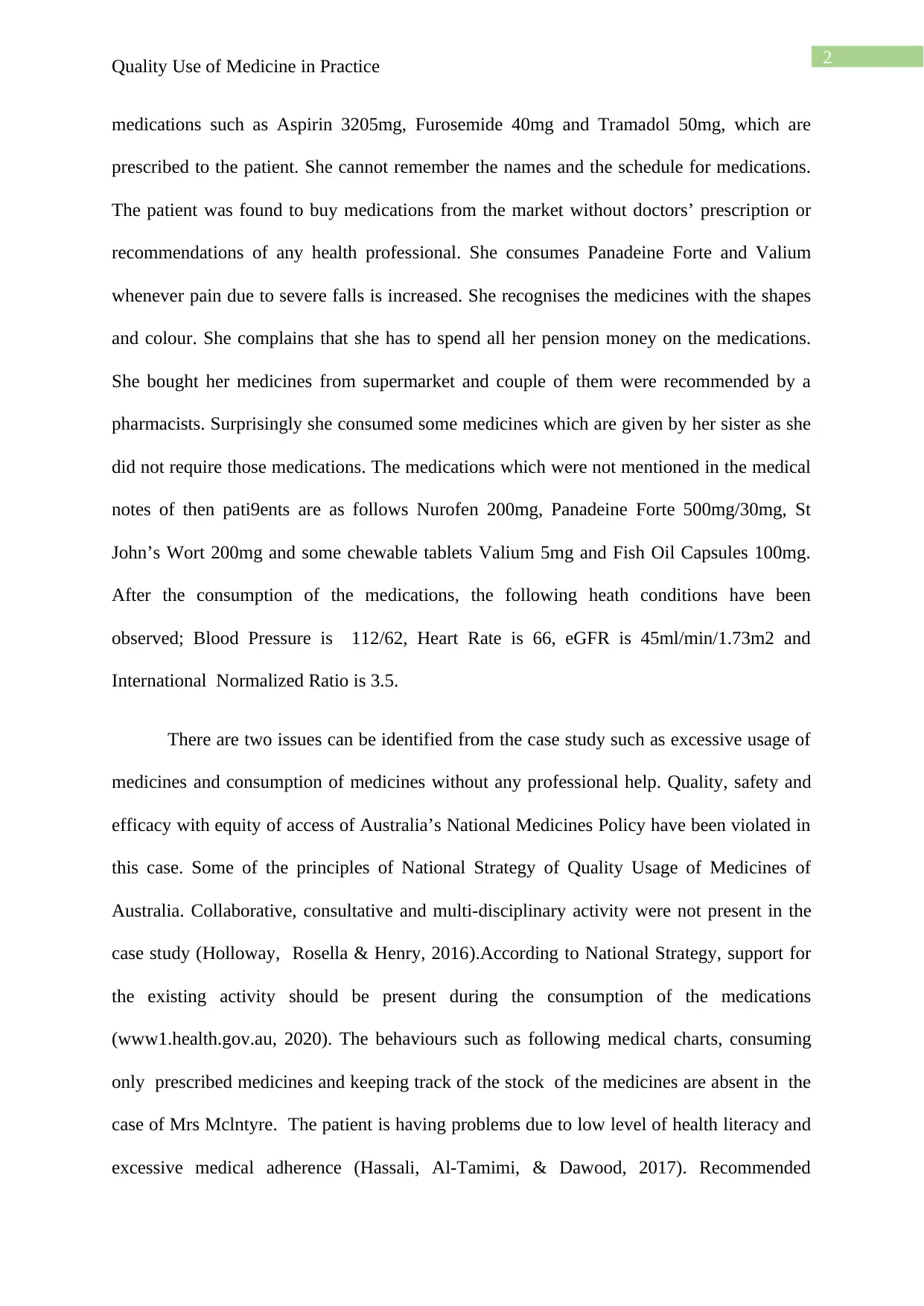
2Quality Use of Medicine in Practice
medications such as Aspirin 3205mg, Furosemide 40mg and Tramadol 50mg, which are
prescribed to the patient. She cannot remember the names and the schedule for medications.
The patient was found to buy medications from the market without doctors’ prescription or
recommendations of any health professional. She consumes Panadeine Forte and Valium
whenever pain due to severe falls is increased. She recognises the medicines with the shapes
and colour. She complains that she has to spend all her pension money on the medications.
She bought her medicines from supermarket and couple of them were recommended by a
pharmacists. Surprisingly she consumed some medicines which are given by her sister as she
did not require those medications. The medications which were not mentioned in the medical
notes of then pati9ents are as follows Nurofen 200mg, Panadeine Forte 500mg/30mg, St
John’s Wort 200mg and some chewable tablets Valium 5mg and Fish Oil Capsules 100mg.
After the consumption of the medications, the following heath conditions have been
observed; Blood Pressure is 112/62, Heart Rate is 66, eGFR is 45ml/min/1.73m2 and
International Normalized Ratio is 3.5.
There are two issues can be identified from the case study such as excessive usage of
medicines and consumption of medicines without any professional help. Quality, safety and
efficacy with equity of access of Australia’s National Medicines Policy have been violated in
this case. Some of the principles of National Strategy of Quality Usage of Medicines of
Australia. Collaborative, consultative and multi-disciplinary activity were not present in the
case study (Holloway, Rosella & Henry, 2016).According to National Strategy, support for
the existing activity should be present during the consumption of the medications
(www1.health.gov.au, 2020). The behaviours such as following medical charts, consuming
only prescribed medicines and keeping track of the stock of the medicines are absent in the
case of Mrs Mclntyre. The patient is having problems due to low level of health literacy and
excessive medical adherence (Hassali, Al-Tamimi, & Dawood, 2017). Recommended
medications such as Aspirin 3205mg, Furosemide 40mg and Tramadol 50mg, which are
prescribed to the patient. She cannot remember the names and the schedule for medications.
The patient was found to buy medications from the market without doctors’ prescription or
recommendations of any health professional. She consumes Panadeine Forte and Valium
whenever pain due to severe falls is increased. She recognises the medicines with the shapes
and colour. She complains that she has to spend all her pension money on the medications.
She bought her medicines from supermarket and couple of them were recommended by a
pharmacists. Surprisingly she consumed some medicines which are given by her sister as she
did not require those medications. The medications which were not mentioned in the medical
notes of then pati9ents are as follows Nurofen 200mg, Panadeine Forte 500mg/30mg, St
John’s Wort 200mg and some chewable tablets Valium 5mg and Fish Oil Capsules 100mg.
After the consumption of the medications, the following heath conditions have been
observed; Blood Pressure is 112/62, Heart Rate is 66, eGFR is 45ml/min/1.73m2 and
International Normalized Ratio is 3.5.
There are two issues can be identified from the case study such as excessive usage of
medicines and consumption of medicines without any professional help. Quality, safety and
efficacy with equity of access of Australia’s National Medicines Policy have been violated in
this case. Some of the principles of National Strategy of Quality Usage of Medicines of
Australia. Collaborative, consultative and multi-disciplinary activity were not present in the
case study (Holloway, Rosella & Henry, 2016).According to National Strategy, support for
the existing activity should be present during the consumption of the medications
(www1.health.gov.au, 2020). The behaviours such as following medical charts, consuming
only prescribed medicines and keeping track of the stock of the medicines are absent in the
case of Mrs Mclntyre. The patient is having problems due to low level of health literacy and
excessive medical adherence (Hassali, Al-Tamimi, & Dawood, 2017). Recommended
⊘ This is a preview!⊘
Do you want full access?
Subscribe today to unlock all pages.

Trusted by 1+ million students worldwide
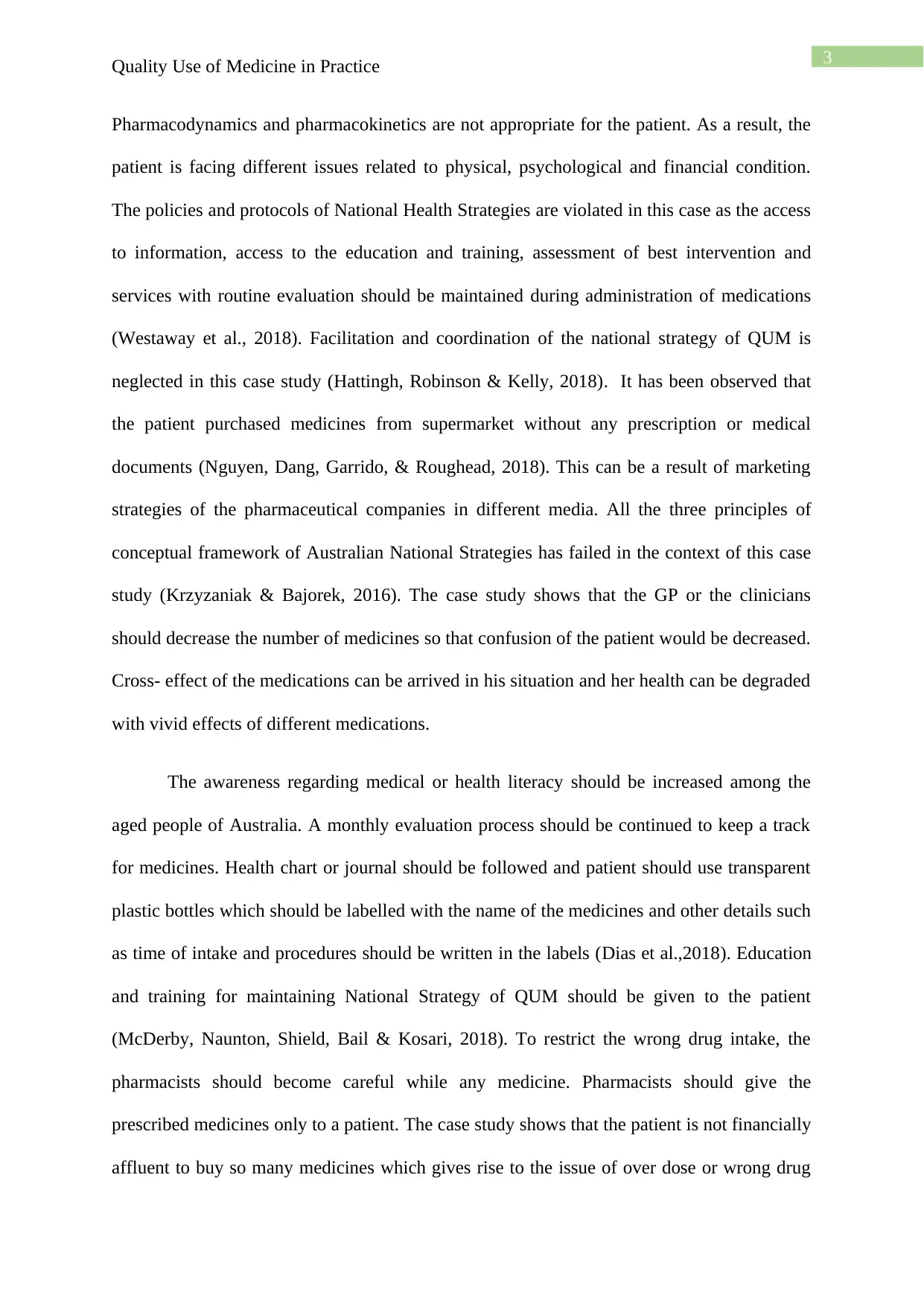
3Quality Use of Medicine in Practice
Pharmacodynamics and pharmacokinetics are not appropriate for the patient. As a result, the
patient is facing different issues related to physical, psychological and financial condition.
The policies and protocols of National Health Strategies are violated in this case as the access
to information, access to the education and training, assessment of best intervention and
services with routine evaluation should be maintained during administration of medications
(Westaway et al., 2018). Facilitation and coordination of the national strategy of QUM is
neglected in this case study (Hattingh, Robinson & Kelly, 2018). It has been observed that
the patient purchased medicines from supermarket without any prescription or medical
documents (Nguyen, Dang, Garrido, & Roughead, 2018). This can be a result of marketing
strategies of the pharmaceutical companies in different media. All the three principles of
conceptual framework of Australian National Strategies has failed in the context of this case
study (Krzyzaniak & Bajorek, 2016). The case study shows that the GP or the clinicians
should decrease the number of medicines so that confusion of the patient would be decreased.
Cross- effect of the medications can be arrived in his situation and her health can be degraded
with vivid effects of different medications.
The awareness regarding medical or health literacy should be increased among the
aged people of Australia. A monthly evaluation process should be continued to keep a track
for medicines. Health chart or journal should be followed and patient should use transparent
plastic bottles which should be labelled with the name of the medicines and other details such
as time of intake and procedures should be written in the labels (Dias et al.,2018). Education
and training for maintaining National Strategy of QUM should be given to the patient
(McDerby, Naunton, Shield, Bail & Kosari, 2018). To restrict the wrong drug intake, the
pharmacists should become careful while any medicine. Pharmacists should give the
prescribed medicines only to a patient. The case study shows that the patient is not financially
affluent to buy so many medicines which gives rise to the issue of over dose or wrong drug
Pharmacodynamics and pharmacokinetics are not appropriate for the patient. As a result, the
patient is facing different issues related to physical, psychological and financial condition.
The policies and protocols of National Health Strategies are violated in this case as the access
to information, access to the education and training, assessment of best intervention and
services with routine evaluation should be maintained during administration of medications
(Westaway et al., 2018). Facilitation and coordination of the national strategy of QUM is
neglected in this case study (Hattingh, Robinson & Kelly, 2018). It has been observed that
the patient purchased medicines from supermarket without any prescription or medical
documents (Nguyen, Dang, Garrido, & Roughead, 2018). This can be a result of marketing
strategies of the pharmaceutical companies in different media. All the three principles of
conceptual framework of Australian National Strategies has failed in the context of this case
study (Krzyzaniak & Bajorek, 2016). The case study shows that the GP or the clinicians
should decrease the number of medicines so that confusion of the patient would be decreased.
Cross- effect of the medications can be arrived in his situation and her health can be degraded
with vivid effects of different medications.
The awareness regarding medical or health literacy should be increased among the
aged people of Australia. A monthly evaluation process should be continued to keep a track
for medicines. Health chart or journal should be followed and patient should use transparent
plastic bottles which should be labelled with the name of the medicines and other details such
as time of intake and procedures should be written in the labels (Dias et al.,2018). Education
and training for maintaining National Strategy of QUM should be given to the patient
(McDerby, Naunton, Shield, Bail & Kosari, 2018). To restrict the wrong drug intake, the
pharmacists should become careful while any medicine. Pharmacists should give the
prescribed medicines only to a patient. The case study shows that the patient is not financially
affluent to buy so many medicines which gives rise to the issue of over dose or wrong drug
Paraphrase This Document
Need a fresh take? Get an instant paraphrase of this document with our AI Paraphraser
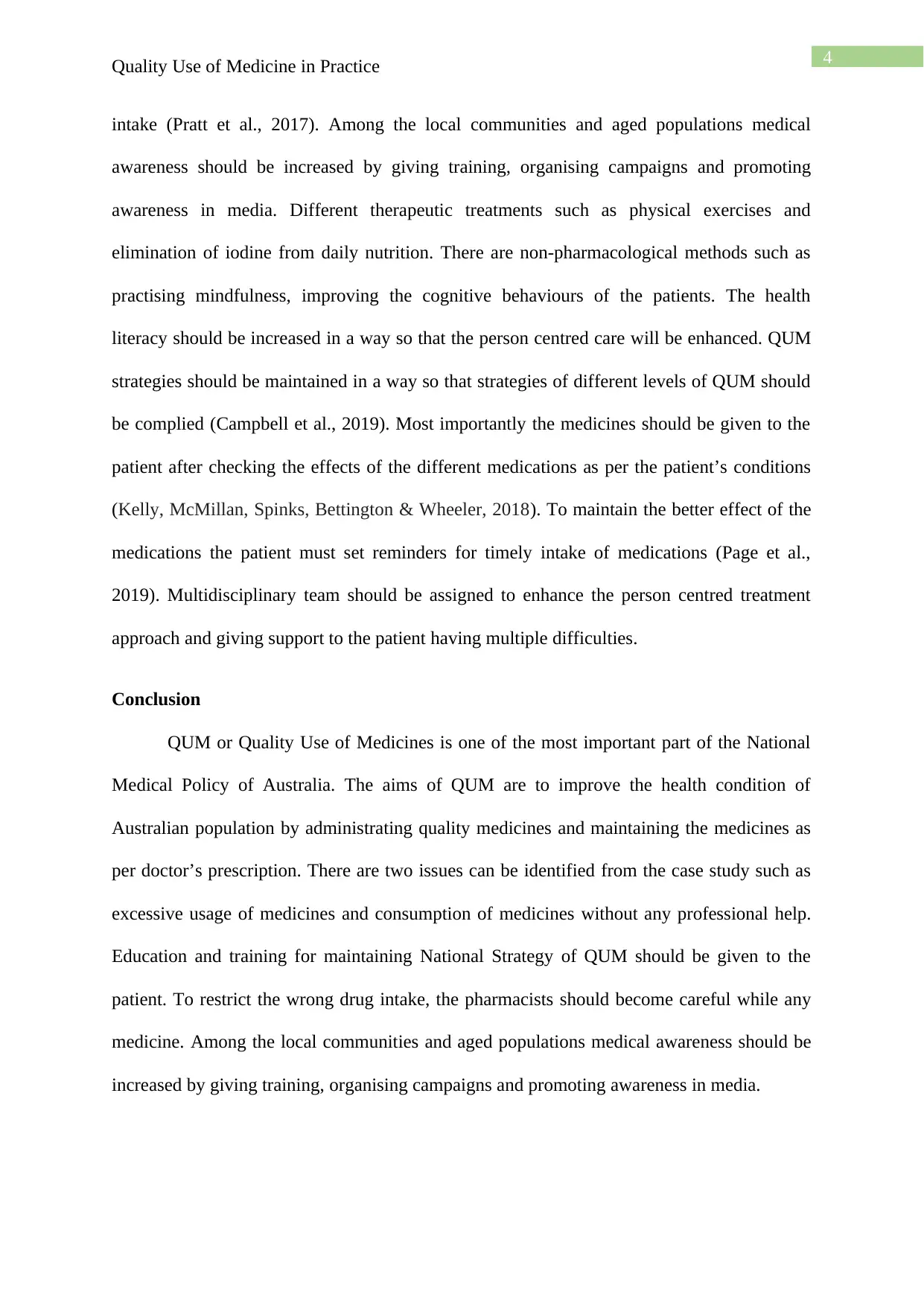
4Quality Use of Medicine in Practice
intake (Pratt et al., 2017). Among the local communities and aged populations medical
awareness should be increased by giving training, organising campaigns and promoting
awareness in media. Different therapeutic treatments such as physical exercises and
elimination of iodine from daily nutrition. There are non-pharmacological methods such as
practising mindfulness, improving the cognitive behaviours of the patients. The health
literacy should be increased in a way so that the person centred care will be enhanced. QUM
strategies should be maintained in a way so that strategies of different levels of QUM should
be complied (Campbell et al., 2019). Most importantly the medicines should be given to the
patient after checking the effects of the different medications as per the patient’s conditions
(Kelly, McMillan, Spinks, Bettington & Wheeler, 2018). To maintain the better effect of the
medications the patient must set reminders for timely intake of medications (Page et al.,
2019). Multidisciplinary team should be assigned to enhance the person centred treatment
approach and giving support to the patient having multiple difficulties.
Conclusion
QUM or Quality Use of Medicines is one of the most important part of the National
Medical Policy of Australia. The aims of QUM are to improve the health condition of
Australian population by administrating quality medicines and maintaining the medicines as
per doctor’s prescription. There are two issues can be identified from the case study such as
excessive usage of medicines and consumption of medicines without any professional help.
Education and training for maintaining National Strategy of QUM should be given to the
patient. To restrict the wrong drug intake, the pharmacists should become careful while any
medicine. Among the local communities and aged populations medical awareness should be
increased by giving training, organising campaigns and promoting awareness in media.
intake (Pratt et al., 2017). Among the local communities and aged populations medical
awareness should be increased by giving training, organising campaigns and promoting
awareness in media. Different therapeutic treatments such as physical exercises and
elimination of iodine from daily nutrition. There are non-pharmacological methods such as
practising mindfulness, improving the cognitive behaviours of the patients. The health
literacy should be increased in a way so that the person centred care will be enhanced. QUM
strategies should be maintained in a way so that strategies of different levels of QUM should
be complied (Campbell et al., 2019). Most importantly the medicines should be given to the
patient after checking the effects of the different medications as per the patient’s conditions
(Kelly, McMillan, Spinks, Bettington & Wheeler, 2018). To maintain the better effect of the
medications the patient must set reminders for timely intake of medications (Page et al.,
2019). Multidisciplinary team should be assigned to enhance the person centred treatment
approach and giving support to the patient having multiple difficulties.
Conclusion
QUM or Quality Use of Medicines is one of the most important part of the National
Medical Policy of Australia. The aims of QUM are to improve the health condition of
Australian population by administrating quality medicines and maintaining the medicines as
per doctor’s prescription. There are two issues can be identified from the case study such as
excessive usage of medicines and consumption of medicines without any professional help.
Education and training for maintaining National Strategy of QUM should be given to the
patient. To restrict the wrong drug intake, the pharmacists should become careful while any
medicine. Among the local communities and aged populations medical awareness should be
increased by giving training, organising campaigns and promoting awareness in media.
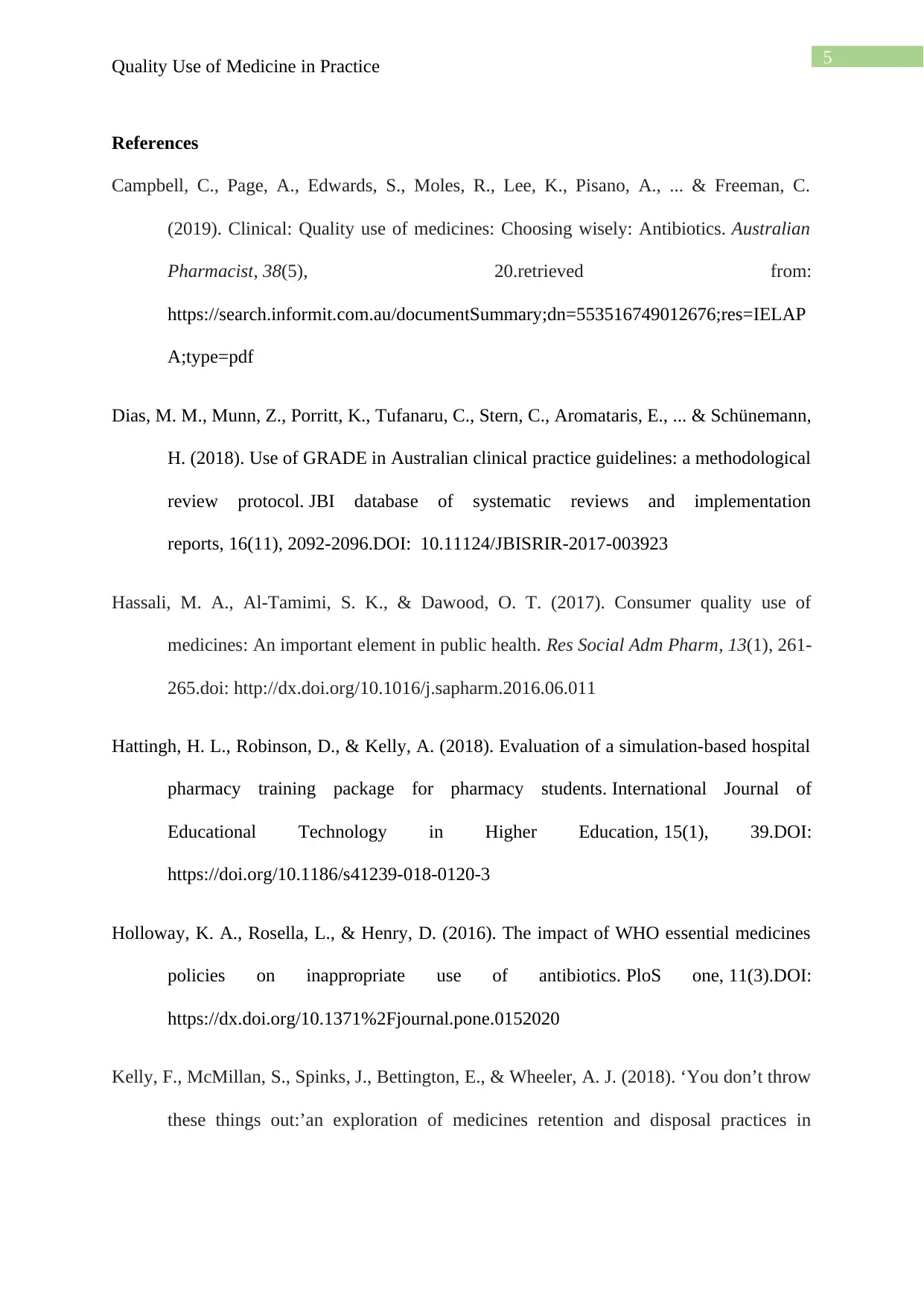
5Quality Use of Medicine in Practice
References
Campbell, C., Page, A., Edwards, S., Moles, R., Lee, K., Pisano, A., ... & Freeman, C.
(2019). Clinical: Quality use of medicines: Choosing wisely: Antibiotics. Australian
Pharmacist, 38(5), 20.retrieved from:
https://search.informit.com.au/documentSummary;dn=553516749012676;res=IELAP
A;type=pdf
Dias, M. M., Munn, Z., Porritt, K., Tufanaru, C., Stern, C., Aromataris, E., ... & Schünemann,
H. (2018). Use of GRADE in Australian clinical practice guidelines: a methodological
review protocol. JBI database of systematic reviews and implementation
reports, 16(11), 2092-2096.DOI: 10.11124/JBISRIR-2017-003923
Hassali, M. A., Al-Tamimi, S. K., & Dawood, O. T. (2017). Consumer quality use of
medicines: An important element in public health. Res Social Adm Pharm, 13(1), 261-
265.doi: http://dx.doi.org/10.1016/j.sapharm.2016.06.011
Hattingh, H. L., Robinson, D., & Kelly, A. (2018). Evaluation of a simulation-based hospital
pharmacy training package for pharmacy students. International Journal of
Educational Technology in Higher Education, 15(1), 39.DOI:
https://doi.org/10.1186/s41239-018-0120-3
Holloway, K. A., Rosella, L., & Henry, D. (2016). The impact of WHO essential medicines
policies on inappropriate use of antibiotics. PloS one, 11(3).DOI:
https://dx.doi.org/10.1371%2Fjournal.pone.0152020
Kelly, F., McMillan, S., Spinks, J., Bettington, E., & Wheeler, A. J. (2018). ‘You don’t throw
these things out:’an exploration of medicines retention and disposal practices in
References
Campbell, C., Page, A., Edwards, S., Moles, R., Lee, K., Pisano, A., ... & Freeman, C.
(2019). Clinical: Quality use of medicines: Choosing wisely: Antibiotics. Australian
Pharmacist, 38(5), 20.retrieved from:
https://search.informit.com.au/documentSummary;dn=553516749012676;res=IELAP
A;type=pdf
Dias, M. M., Munn, Z., Porritt, K., Tufanaru, C., Stern, C., Aromataris, E., ... & Schünemann,
H. (2018). Use of GRADE in Australian clinical practice guidelines: a methodological
review protocol. JBI database of systematic reviews and implementation
reports, 16(11), 2092-2096.DOI: 10.11124/JBISRIR-2017-003923
Hassali, M. A., Al-Tamimi, S. K., & Dawood, O. T. (2017). Consumer quality use of
medicines: An important element in public health. Res Social Adm Pharm, 13(1), 261-
265.doi: http://dx.doi.org/10.1016/j.sapharm.2016.06.011
Hattingh, H. L., Robinson, D., & Kelly, A. (2018). Evaluation of a simulation-based hospital
pharmacy training package for pharmacy students. International Journal of
Educational Technology in Higher Education, 15(1), 39.DOI:
https://doi.org/10.1186/s41239-018-0120-3
Holloway, K. A., Rosella, L., & Henry, D. (2016). The impact of WHO essential medicines
policies on inappropriate use of antibiotics. PloS one, 11(3).DOI:
https://dx.doi.org/10.1371%2Fjournal.pone.0152020
Kelly, F., McMillan, S., Spinks, J., Bettington, E., & Wheeler, A. J. (2018). ‘You don’t throw
these things out:’an exploration of medicines retention and disposal practices in
⊘ This is a preview!⊘
Do you want full access?
Subscribe today to unlock all pages.

Trusted by 1+ million students worldwide
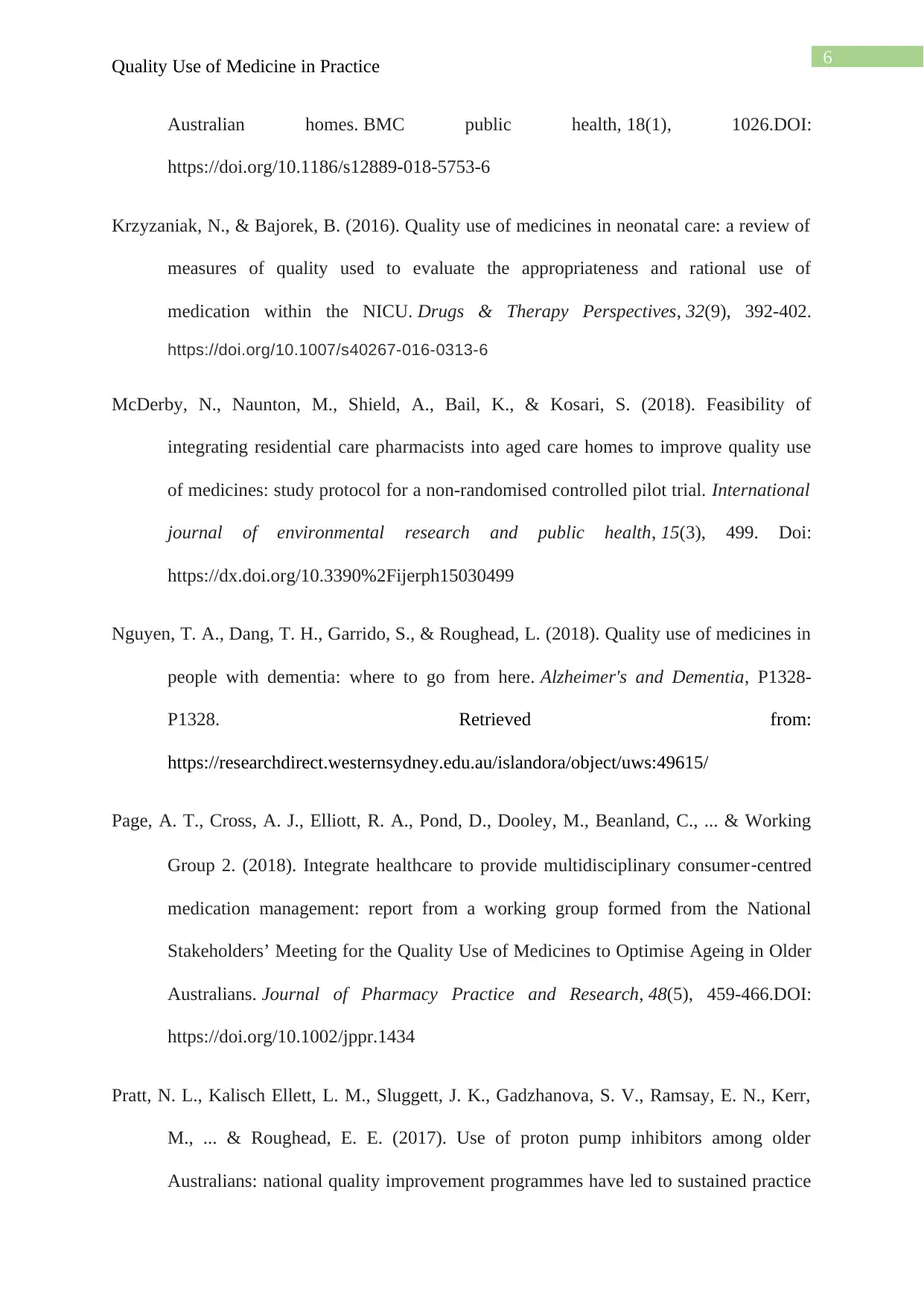
6Quality Use of Medicine in Practice
Australian homes. BMC public health, 18(1), 1026.DOI:
https://doi.org/10.1186/s12889-018-5753-6
Krzyzaniak, N., & Bajorek, B. (2016). Quality use of medicines in neonatal care: a review of
measures of quality used to evaluate the appropriateness and rational use of
medication within the NICU. Drugs & Therapy Perspectives, 32(9), 392-402.
https://doi.org/10.1007/s40267-016-0313-6
McDerby, N., Naunton, M., Shield, A., Bail, K., & Kosari, S. (2018). Feasibility of
integrating residential care pharmacists into aged care homes to improve quality use
of medicines: study protocol for a non-randomised controlled pilot trial. International
journal of environmental research and public health, 15(3), 499. Doi:
https://dx.doi.org/10.3390%2Fijerph15030499
Nguyen, T. A., Dang, T. H., Garrido, S., & Roughead, L. (2018). Quality use of medicines in
people with dementia: where to go from here. Alzheimer's and Dementia, P1328-
P1328. Retrieved from:
https://researchdirect.westernsydney.edu.au/islandora/object/uws:49615/
Page, A. T., Cross, A. J., Elliott, R. A., Pond, D., Dooley, M., Beanland, C., ... & Working
Group 2. (2018). Integrate healthcare to provide multidisciplinary consumer‐centred
medication management: report from a working group formed from the National
Stakeholders’ Meeting for the Quality Use of Medicines to Optimise Ageing in Older
Australians. Journal of Pharmacy Practice and Research, 48(5), 459-466.DOI:
https://doi.org/10.1002/jppr.1434
Pratt, N. L., Kalisch Ellett, L. M., Sluggett, J. K., Gadzhanova, S. V., Ramsay, E. N., Kerr,
M., ... & Roughead, E. E. (2017). Use of proton pump inhibitors among older
Australians: national quality improvement programmes have led to sustained practice
Australian homes. BMC public health, 18(1), 1026.DOI:
https://doi.org/10.1186/s12889-018-5753-6
Krzyzaniak, N., & Bajorek, B. (2016). Quality use of medicines in neonatal care: a review of
measures of quality used to evaluate the appropriateness and rational use of
medication within the NICU. Drugs & Therapy Perspectives, 32(9), 392-402.
https://doi.org/10.1007/s40267-016-0313-6
McDerby, N., Naunton, M., Shield, A., Bail, K., & Kosari, S. (2018). Feasibility of
integrating residential care pharmacists into aged care homes to improve quality use
of medicines: study protocol for a non-randomised controlled pilot trial. International
journal of environmental research and public health, 15(3), 499. Doi:
https://dx.doi.org/10.3390%2Fijerph15030499
Nguyen, T. A., Dang, T. H., Garrido, S., & Roughead, L. (2018). Quality use of medicines in
people with dementia: where to go from here. Alzheimer's and Dementia, P1328-
P1328. Retrieved from:
https://researchdirect.westernsydney.edu.au/islandora/object/uws:49615/
Page, A. T., Cross, A. J., Elliott, R. A., Pond, D., Dooley, M., Beanland, C., ... & Working
Group 2. (2018). Integrate healthcare to provide multidisciplinary consumer‐centred
medication management: report from a working group formed from the National
Stakeholders’ Meeting for the Quality Use of Medicines to Optimise Ageing in Older
Australians. Journal of Pharmacy Practice and Research, 48(5), 459-466.DOI:
https://doi.org/10.1002/jppr.1434
Pratt, N. L., Kalisch Ellett, L. M., Sluggett, J. K., Gadzhanova, S. V., Ramsay, E. N., Kerr,
M., ... & Roughead, E. E. (2017). Use of proton pump inhibitors among older
Australians: national quality improvement programmes have led to sustained practice
Paraphrase This Document
Need a fresh take? Get an instant paraphrase of this document with our AI Paraphraser
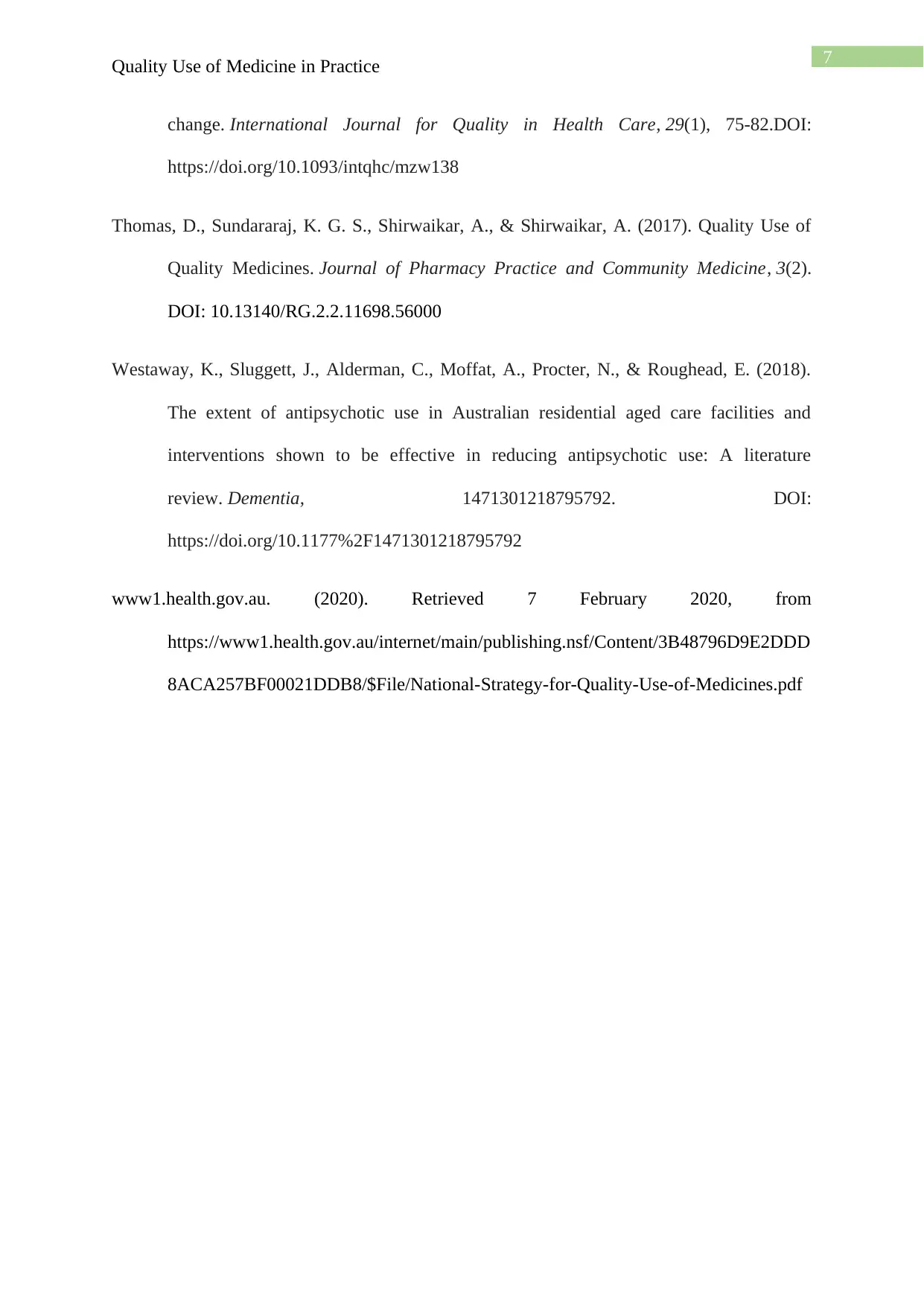
7Quality Use of Medicine in Practice
change. International Journal for Quality in Health Care, 29(1), 75-82.DOI:
https://doi.org/10.1093/intqhc/mzw138
Thomas, D., Sundararaj, K. G. S., Shirwaikar, A., & Shirwaikar, A. (2017). Quality Use of
Quality Medicines. Journal of Pharmacy Practice and Community Medicine, 3(2).
DOI: 10.13140/RG.2.2.11698.56000
Westaway, K., Sluggett, J., Alderman, C., Moffat, A., Procter, N., & Roughead, E. (2018).
The extent of antipsychotic use in Australian residential aged care facilities and
interventions shown to be effective in reducing antipsychotic use: A literature
review. Dementia, 1471301218795792. DOI:
https://doi.org/10.1177%2F1471301218795792
www1.health.gov.au. (2020). Retrieved 7 February 2020, from
https://www1.health.gov.au/internet/main/publishing.nsf/Content/3B48796D9E2DDD
8ACA257BF00021DDB8/$File/National-Strategy-for-Quality-Use-of-Medicines.pdf
change. International Journal for Quality in Health Care, 29(1), 75-82.DOI:
https://doi.org/10.1093/intqhc/mzw138
Thomas, D., Sundararaj, K. G. S., Shirwaikar, A., & Shirwaikar, A. (2017). Quality Use of
Quality Medicines. Journal of Pharmacy Practice and Community Medicine, 3(2).
DOI: 10.13140/RG.2.2.11698.56000
Westaway, K., Sluggett, J., Alderman, C., Moffat, A., Procter, N., & Roughead, E. (2018).
The extent of antipsychotic use in Australian residential aged care facilities and
interventions shown to be effective in reducing antipsychotic use: A literature
review. Dementia, 1471301218795792. DOI:
https://doi.org/10.1177%2F1471301218795792
www1.health.gov.au. (2020). Retrieved 7 February 2020, from
https://www1.health.gov.au/internet/main/publishing.nsf/Content/3B48796D9E2DDD
8ACA257BF00021DDB8/$File/National-Strategy-for-Quality-Use-of-Medicines.pdf
1 out of 8
Related Documents
Your All-in-One AI-Powered Toolkit for Academic Success.
+13062052269
info@desklib.com
Available 24*7 on WhatsApp / Email
![[object Object]](/_next/static/media/star-bottom.7253800d.svg)
Unlock your academic potential
Copyright © 2020–2025 A2Z Services. All Rights Reserved. Developed and managed by ZUCOL.





